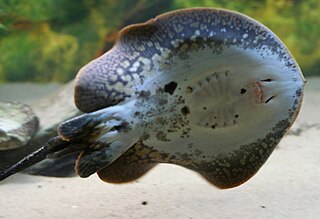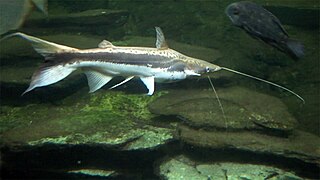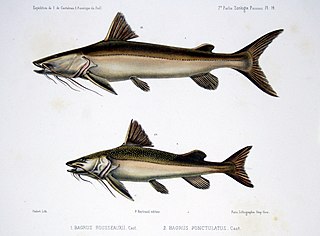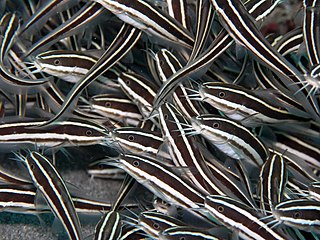
Callichthyidae is a family of catfishes, called armored catfishes due to the two rows of bony plates along the lengths of their bodies. It contains some of the most popular freshwater aquarium fish, such as many species in the genus Corydoras.

Trichomycteridae is a family of catfishes commonly known as pencil catfishes or parasitic catfishes. This family includes the candiru fish, feared by some people for its alleged habit of entering into the urethra of humans. They are one of the few parasitic chordates. Another species is the life monsefuano which was important to the Moche culture and still an important part of Peruvian cuisine.
Listrura is a genus of pencil catfishes native to South America.

The long-tailed river stingray or antenna ray is a species of freshwater stingray in the family Potamotrygonidae. It is found in the Amazon basin in South America, ranging from Ecuador to Belém. It lives in the main channel of the Amazon River and lower parts of its major tributaries.

Rineloricaria is a genus of freshwater tropical catfish belonging to the family Loricariidae. They are commonly called whiptail catfish because of the long filament that grows out of the tip of the caudal fin that is characteristic of the genus. With the exception of R. altipinnis from Panama, they are native to the rivers of northern and central South America. Some species are regularly seen in the aquarium trade.

Chaca is the only genus in the catfish family Chacidae. These fish are commonly known as squarehead catfishes, frogmouth catfishes, or angler catfishes. These unusual fish have a sedentary lifestyle and spend much of their time motionless.

Sorubim is a small genus of long-whiskered catfish native to tropical South America. A number of characteristics allows the differentiation of each species in the genus. Sorubim species are important food fish in South America and are highly significant to fisheries of some areas; however, harvests of these fish are not identified as much as other, more popular food fishes such as Colossoma, Arapaima, and Brachyplatystoma. Some species of this family are popular aquarium fish.

Brachyplatystoma is a genus of catfish from the family Pimelodidae. As the occasionally used common name goliath catfishes indicates, this genus includes some of the largest species of catfish, including the piraíba, B. filamentosum, which reaches up to the region of 3.6 metres (12 ft) in length. Brachyplatystoma are found in the Amazon and Orinoco basins, and other tropical freshwater and brackish habitats in South America. Some species are migratory. These fish are important as food fish and, to some extent, aquarium fish.

Steindachneridion is a genus of South American pimelodid catfish.
Iheringichthys is a small genus of long-whiskered catfish native to South America.

Pseudopimelodus is a genus of catfishes of the family Pseudopimelodidae.

Leiarius is a genus of long-whiskered catfishes native to South America. Most of the genus' species are found in the aquarium hobby as ornamental fish.
Glaphyropoma is a genus of small pencil catfishes native to Bahia in Brazil.
Paravandellia is a genus of pencil catfishes native to South America.

Sisor is a genus of catfishes native to Asia.
Stegophilus is a genus of pencil catfishes native to South America.
Euristhmus is a genus of eeltail catfishes native to the eastern Indian-western Pacific Oceans around Australia, New Guinea and Indonesia.

Plotosus is a genus of eeltail catfishes native to the Indian Ocean, the western Pacific Ocean and New Guinea.
Ceratoglanis is a genus of sheatfishes native to Asia.

Fish are very diverse animals and can be categorised in many ways. Although most fish species have probably been discovered and described, about 250 new ones are still discovered every year. According to FishBase about 34,800 species of fish had been described as of February 2022, which is more than the combined total of all other vertebrate species: mammals, amphibians, reptiles and birds.












